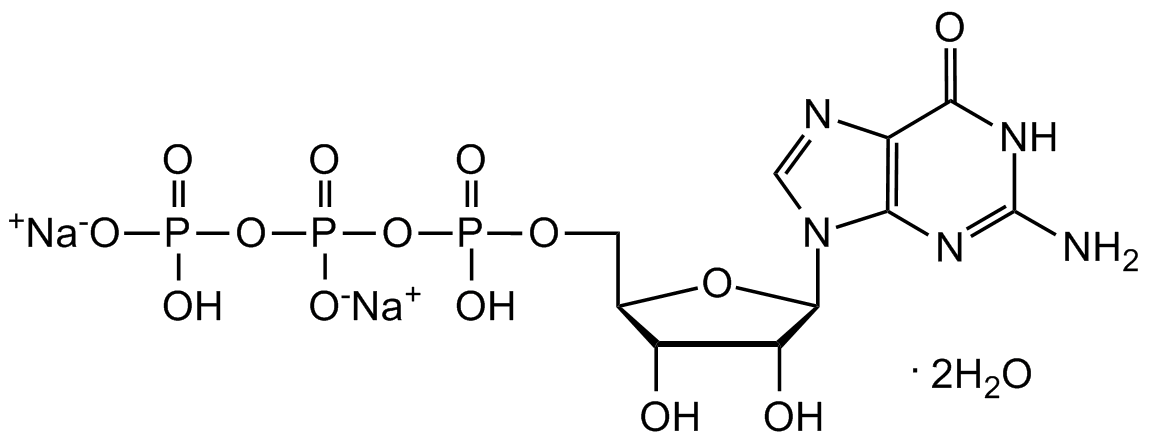Guanosine 5'-triphosphate sodium salt hydrate
| Code | Size | Price |
|---|
| CDX-G0069-M250 | 250 mg | £164.00 |
Quantity:
| CDX-G0069-G001 | 1 g | £469.00 |
Quantity:
Prices exclude any Taxes / VAT
Overview
Regulatory Status: RUO
Shipping:
AMBIENT
Storage:
Short Term Storage: -20?C. Long Term Storage: -20?C
Images
Documents
Further Information
Alternate Names/Synonyms:
GTP; 5'-GTP Salt
Appearance:
White to off-white powder.
CAS:
36051-31-7
EClass:
32160000
Form (Short):
solid
Handling Advice:
Protect from light and moisture.
InChi:
InChI=1S/C10H16N5O14P3.2Na/c11-10-13-7-4(8(18)14-10)12-2-15(7)9-6(17)5(16)3(27-9)1-26-31(22,23)29-32(24,25)28-30(19,20)21;;/h2-3,5-6,9,16-17H,1H2,(H,22,23)(H,24,25)(H2,19,20,21)(H3,11,13,14,18);;/q;2*+1/p-2/t3-,5-,6-,9-;;/m1./s1
InChiKey:
FIZIYLKEXVIRHJ-LGVAUZIVSA-L
Long Description:
Chemical. CAS: 36051-31-7. Formula: C10H16N5O14P3 . xNa+. Molecular Weight: 523.18 (free acid basis). Guanosine 5'-triphosphate (GTP) trisodium salt activates the signal transducing G proteins which are involved in various cellular processes including proliferation, differentiation and activation of several intracellular kinase cascades. Proliferation and apoptosis are regulated in part by the hydrolysis of GTP by small GTPases Ras and Rho. Another type of small GTPase, Rab, plays a role in the docking and fusion of vesicles and may also be involved in vesicle GTP functions as a carrier of phosphates and pyrophosphates involved in channeling chemical energy into specific biosynthetic pathways. It also serves as an energy-rich precursor of mononucleotide units in the enzymatic biosynthesis of DNA and RNA. GTP is involved in the initiation of peptide synthesis during the binding of formylmethionyl-tRNA (F-met-tRNA) to the ribosome. It is also involved in polypeptide chain elongation. GTP is hydrolyzed by tubulin and its hydrolysis is accompanied by microtubule assembly. Guanosine 5'-triphosphate trisodium salt up-regulates miRNA (specifically miR133a and miR133b) and myogenic regulator factor and induces human myogenic precursor cells to release exosomes stuffed with guanosine based molecules (mainly guanosine) in the extracellular milieu.
MDL:
MFCD00077781
Molecular Formula:
C10H16N5O14P3 . xNa+
Molecular Weight:
523.18 (free acid basis)
Package Type:
Vial
Product Description:
Guanosine 5'-triphosphate (GTP) trisodium salt activates the signal transducing G proteins which are involved in various cellular processes including proliferation, differentiation and activation of several intracellular kinase cascades. Proliferation and apoptosis are regulated in part by the hydrolysis of GTP by small GTPases Ras and Rho. Another type of small GTPase, Rab, plays a role in the docking and fusion of vesicles and may also be involved in vesicle GTP functions as a carrier of phosphates and pyrophosphates involved in channeling chemical energy into specific biosynthetic pathways. It also serves as an energy-rich precursor of mononucleotide units in the enzymatic biosynthesis of DNA and RNA. GTP is involved in the initiation of peptide synthesis during the binding of formylmethionyl-tRNA (F-met-tRNA) to the ribosome. It is also involved in polypeptide chain elongation. GTP is hydrolyzed by tubulin and its hydrolysis is accompanied by microtubule assembly. Guanosine 5'-triphosphate trisodium salt up-regulates miRNA (specifically miR133a and miR133b) and myogenic regulator factor and induces human myogenic precursor cells to release exosomes stuffed with guanosine based molecules (mainly guanosine) in the extracellular milieu.
Purity:
>97% (NMR)
SMILES:
O[C@@H]1[C@H](O)[C@@H](COP(O)(OP(OP(O)([O-])=O)([O-])=O)=O)O[C@H]1N2C(N=C(N)NC3=O)=C3N=C2.[Na+].[Na+]
Solubility Chemicals:
Soluble in water (50mg/ml).
Transportation:
Non-hazardous
UNSPSC Category:
Biochemical Reagents
UNSPSC Number:
12352200
Use & Stability:
Stable for at least 2 years after receipt when stored at -20?C.
References
(1) Y. Kaziro; Biochim. Biophys. Acta 505, 95 (1978) (Review) | (2) M.F. Carlier; Mol. Cell Biochem. 47, 97 (1982) (Review) | (3) M.L. Pall; Curr. Top. Cell Regul. 25, 1 (1985) (Review) | (4) F. McCormick; Curr. Opin. Cell Biol. 2, 181 (1990) (Review) | (5) J.C. Lacal; FEBS Lett. 410, 73 (1997) | (6) J.S. Gutkind; Oncogene 17, 1331 (1998) | (7) N. Dhanasekaran, et al.; Oncogene 17, 1383 (1998) | (8) F. Schimmoller, et al.; J. Biol. Chem. 273, 22161 (1998) | (9) J. Gomez, et al.; Immunol. Cell Biol. 76, 125 (1998) | (10) P. Woodman; Curr. Biol. 8, R199 (1998) | (11) U.G. Knaus; Immunol. Res. 21, 103 (2000) (Review) | (12) F. Blombach, et al.; Biochem. Soc. Trans. 39, 45 (2011) | (13) O. Haller, et al.; J. Interf. Cytokine Res. 31, 79 (2011) | (14) D. Benjamin & M.N. Hall; Cell Rep. 19, 2643 (2017) (Review) | (15) A. Kowluru; Small GTPases 12, 323 (2021) (Review)



